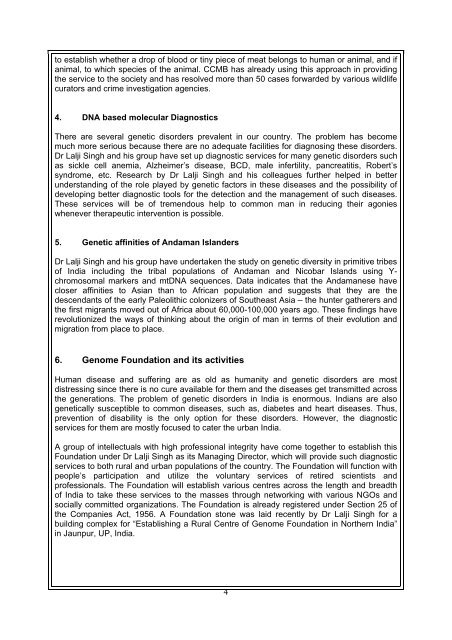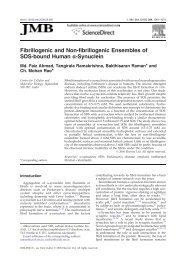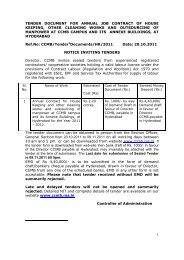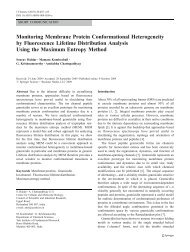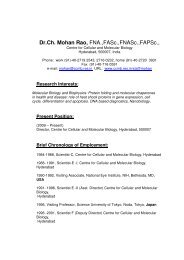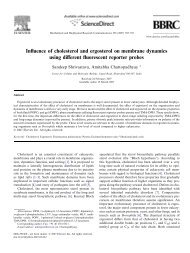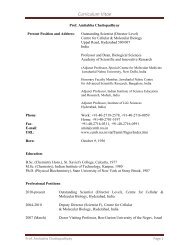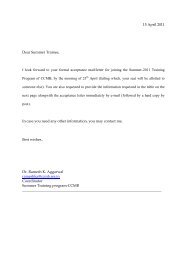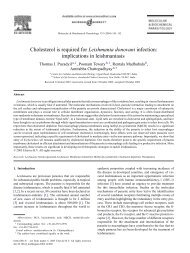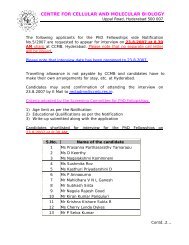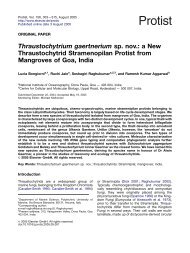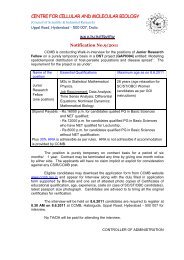Dr Lalji Singh - CCMB
Dr Lalji Singh - CCMB
Dr Lalji Singh - CCMB
You also want an ePaper? Increase the reach of your titles
YUMPU automatically turns print PDFs into web optimized ePapers that Google loves.
to establish whether a drop of blood or tiny piece of meat belongs to human or animal, and if<br />
animal, to which species of the animal. <strong>CCMB</strong> has already using this approach in providing<br />
the service to the society and has resolved more than 50 cases forwarded by various wildlife<br />
curators and crime investigation agencies.<br />
4. DNA based molecular Diagnostics<br />
There are several genetic disorders prevalent in our country. The problem has become<br />
much more serious because there are no adequate facilities for diagnosing these disorders.<br />
<strong>Dr</strong> <strong>Lalji</strong> <strong>Singh</strong> and his group have set up diagnostic services for many genetic disorders such<br />
as sickle cell anemia, Alzheimer’s disease, BCD, male infertility, pancreatitis, Robert’s<br />
syndrome, etc. Research by <strong>Dr</strong> <strong>Lalji</strong> <strong>Singh</strong> and his colleagues further helped in better<br />
understanding of the role played by genetic factors in these diseases and the possibility of<br />
developing better diagnostic tools for the detection and the management of such diseases.<br />
These services will be of tremendous help to common man in reducing their agonies<br />
whenever therapeutic intervention is possible.<br />
5. Genetic affinities of Andaman Islanders<br />
<strong>Dr</strong> <strong>Lalji</strong> <strong>Singh</strong> and his group have undertaken the study on genetic diversity in primitive tribes<br />
of India including the tribal populations of Andaman and Nicobar Islands using Y-<br />
chromosomal markers and mtDNA sequences. Data indicates that the Andamanese have<br />
closer affinities to Asian than to African population and suggests that they are the<br />
descendants of the early Paleolithic colonizers of Southeast Asia – the hunter gatherers and<br />
the first migrants moved out of Africa about 60,000-100,000 years ago. These findings have<br />
revolutionized the ways of thinking about the origin of man in terms of their evolution and<br />
migration from place to place.<br />
6. Genome Foundation and its activities<br />
Human disease and suffering are as old as humanity and genetic disorders are most<br />
distressing since there is no cure available for them and the diseases get transmitted across<br />
the generations. The problem of genetic disorders in India is enormous. Indians are also<br />
genetically susceptible to common diseases, such as, diabetes and heart diseases. Thus,<br />
prevention of disability is the only option for these disorders. However, the diagnostic<br />
services for them are mostly focused to cater the urban India.<br />
A group of intellectuals with high professional integrity have come together to establish this<br />
Foundation under <strong>Dr</strong> <strong>Lalji</strong> <strong>Singh</strong> as its Managing Director, which will provide such diagnostic<br />
services to both rural and urban populations of the country. The Foundation will function with<br />
people’s participation and utilize the voluntary services of retired scientists and<br />
professionals. The Foundation will establish various centres across the length and breadth<br />
of India to take these services to the masses through networking with various NGOs and<br />
socially committed organizations. The Foundation is already registered under Section 25 of<br />
the Companies Act, 1956. A Foundation stone was laid recently by <strong>Dr</strong> <strong>Lalji</strong> <strong>Singh</strong> for a<br />
building complex for “Establishing a Rural Centre of Genome Foundation in Northern India”<br />
in Jaunpur, UP, India.<br />
4


